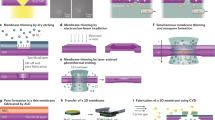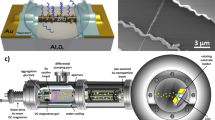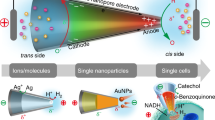Abstract
Detection and quantification of biological and chemical species are central to many areas of healthcare and the life sciences, ranging from diagnosing disease to discovery and screening of new drug molecules. Semiconductor nanowires configured as electronic devices have emerged as a general platform for ultra-sensitive direct electrical detection of biological and chemical species. Here we describe a detailed protocol for realizing nanowire electronic sensors. First, the growth of uniform, single crystal silicon nanowires, and subsequent isolation of the nanowires as stable suspensions are outlined. Second, fabrication of addressable nanowire device arrays is described. Third, covalent modification of the nanowire device surfaces with receptors is described. Fourth, an example modification and measurements of the electrical response from devices are detailed. The silicon nanowire (SiNW) devices have demonstrated applications for label-free, ultrasensitive and highly-selective real-time detection of a wide range of biological and chemical species, including proteins, nucleic acids, small molecules and viruses.
This is a preview of subscription content, access via your institution
Access options
Subscribe to this journal
Receive 12 print issues and online access
$259.00 per year
only $21.58 per issue
Buy this article
- Purchase on Springer Link
- Instant access to full article PDF
Prices may be subject to local taxes which are calculated during checkout












Similar content being viewed by others
References
Morales, A.M. & Lieber, C.M. A laser ablation method for the synthesis of crystalline semiconductor nanowires. Science 279, 208–211 (1998).
Lieber, C.M. Nanoscale science and technology: Building a big future from small things. MRS Bull., 28, 486–491 (2003).
Xiang, J. et al. Ge/Si nanowire heterostructures as high-performance field-effect transistors. Nature 441, 489–493 (2006).
Cui, Y., Zhong, Z., Wang, D., Wang, W.U. & Lieber, C.M. High performance silicon nanowire field effect transistors. Nano Lett. 3, 149–152 (2003).
Jin, S. et al. Scalable interconnection and integration of nanowire devices without registration. Nano Lett. 4, 915–919 (2004).
Patolsky, F. & Lieber, C.M. Nanowire nanosensors. Mater. Today 8, 20–28 (2005).
Cui, Y., Wei, Q., Park, H. & Lieber, C.M. Nanowire nanosensors for highly sensitive and selective detection of biological and chemical species. Science 293, 1289–1292 (2001).
Sze, S.M. Physics of Semiconductor Devices Edn. 2 p. 481 (John Wiley & Sons, New York, 1981).
Domansky, K. & Janata, J. Present state of fabrication of chemically sensitive field-effect transistors. Analyst 118, 335–340 (1993).
Janata, J. 20 Years of ion-selective field-effect transistors. Analyst 119, 2275–2278 (1994).
Hahm, J. & Lieber, C.M. Direct ultrasensitive electrical detection of DNA and DNA sequence variations using nanowire nanosensors. Nano Lett. 4, 51–54 (2004).
Wang, W.U., Chen, C., Lin, K.H., Fang, Y. & Lieber, C.M. Label-free detection of small-molecule-protein interactions by using nanowire nanosensors. Proc. Natl. Acad. Sci. USA 102, 3208–3212 (2005).
Patolsky, F. et al. Electrical detection of single viruses. Proc. Natl. Acad. Sci. USA 101, 14017–14022 (2004).
Zheng, G.F., Patolsky, F., Cui, Y., Wang, W.U. & Lieber, C.M. Multiplexed electrical detection of cancer markers with nanowire sensor arrays. Nat. Biotechnol. 23, 1294–1301 (2005).
Hu, J.T., Odom, T.W. & Lieber, C.M. Chemistry and physics in one dimension: Synthesis and properties of nanowires and nanotubes. Acc. Chem. Res. 32, 435–445 (1999).
Cui, Y., Lauhon, L.J., Gudiksen, M.S., Wang, J. & Lieber, C.M. Diameter-controlled synthesis of single-crystal silicon nanowires. Appl. Phys. Lett. 78, 2214–2216 (2001).
Wu, Y. Controlled growth and structures of molecular-scale silicon nanowires. Nano Lett. 4, 433–436 (2004).
Zheng, G.F., Lu, W., Jin, S. & Lieber, C.M. Synthesis and fabrication of high-performance n-type silicon nanowire transistors. Adv. Mater. 16, 1890–1893 (2004).
Iler, R.K. The Chemistry of Silica: Solubility, Polymerization, Colloid and Surface Properties and Biochemistry of Silica (John Wiley & Sons, New York, 1979).
Ward, A.M., Catto, J.W.F. & Hamdy, F.C. Prostate specific antigen: biology, biochemistry and available commercial assays. Ann. Clin. Biochem. 38, 633–651 (2001).
Mirkin, C.A. et al. A DNA-based method for rationally assembling nanoparticles into macroscopic materials. Nature 382, 607–609 (1996).
Campagnolo, C. et al. Real-Time, label-free monitoring of tumor antigen and serum antibody interactions. J. Biochem. Biophys. Methods 61, 283–298 (2004).
Wu, G.H. et al. Bioassay of prostate-specific antigen (PSA) using microcantilevers. Nat. Biotechnol. 19, 856–860 (2001).
Chen, R.J. et al. Noncovalent functionalization of carbon nanotubes for highly specific electronic biosensors. Proc. Natl. Acad. Sci. USA 100, 4984–4989 (2003).
Patolsky, F., Zheng, G.F. & Lieber, C.M. Nanowire sensors for medicine and the life sciences. Nanomedicine 1, 51–65 (2006).
Patolsky, F., Zheng, G.F. & Lieber, C.M. Nanowire-based biosensors. Anal. Chem. 78, 4261–4269 (2006).
Becker, J. Signal transduction inhibitors – a work in progress. Nat. Biotechnol. 22, 15–18 (2004).
Patolsky, F. et al. Detection, stimulation and inhibition of neuronal signals with high-density nanowire transistor arrays. Science 313, 1100–1104 (2006).
MacBeath, G. & Schreiber, S.L. Printing proteins as microarrays for high-throughput function determination. Science 289, 1760–1763 (2000).
Whitesides, G.M., Ostuni, E., Takayama, S., Jiang, X. & Ingber, D.E. Soft lithography in biology and biochemistry. Annu. Rev. Biomed. Eng. 3, 335 (2001).
Huang, Y., Duan, X.F., Wei, Q.Q. & Lieber, C.M. Directed assembly of one-dimensional nanostructures into functional networks. Science 291, 630–633 (2001).
Whang, D., Jin, S. & Lieber, C.M. Large-scale hierarchical organization of nanowires for functional nanosystems. Japan. J. Appl. Phys. 43, 4465–4470 (2004).
Wu, Y., Xiang, J., Yang, C., Lu, W. & Lieber, C.M. Single-crystal metallic nanowires and metal/semiconductor nanowire heterostructures. Nature 430, 61–65 (2004).
Author information
Authors and Affiliations
Corresponding author
Ethics declarations
Competing interests
The authors declare no competing financial interests.
Rights and permissions
About this article
Cite this article
Patolsky, F., Zheng, G. & Lieber, C. Fabrication of silicon nanowire devices for ultrasensitive, label-free, real-time detection of biological and chemical species. Nat Protoc 1, 1711–1724 (2006). https://doi.org/10.1038/nprot.2006.227
Published:
Issue Date:
DOI: https://doi.org/10.1038/nprot.2006.227
This article is cited by
-
Spacer-Engineered Reconfigurable Silicon Nanowire Schottky Barrier Transistor as a Label-Free Biosensor
Silicon (2024)
-
Single-exonuclease nanocircuits reveal the RNA degradation dynamics of PNPase and demonstrate potential for RNA sequencing
Nature Communications (2023)
-
Progress in group-IV semiconductor nanowires based photonic devices
Applied Physics A (2023)
-
Detection of TNT in sulfuric acid solution by SiNWs-FET based sensor
Microsystem Technologies (2022)
-
Electrical Characterization and Study of Current Drift Phenomena and Hysteresis Mechanism in Junctionless Ion-Sensitive Field-Effect Transistor
Silicon (2022)
Comments
By submitting a comment you agree to abide by our Terms and Community Guidelines. If you find something abusive or that does not comply with our terms or guidelines please flag it as inappropriate.



